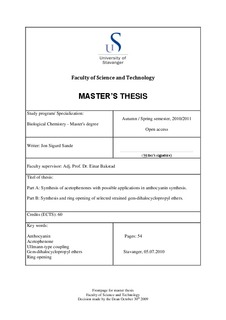| dc.description.abstract | Part A: Synthesis of acetophenones with possible applications in anthocyanin synthesis.
The preparations of 4 acetophenones were investigated: 4-Hydroxy-3,5-dimethoxyacetophenone, 3,4-dihydroxy-5-methoxyacetophenone, 3,4,5-trihydroxyacetophenone and 3,4-dihydroxyacetophenone. These acetophenones can be used to synthesize the natural occurring anthocyanins: Malvidin 3-O-β-D-glucopyranoside chloride, petunidin 3-O-β-D-glucopyranoside chloride, delphinidin 3-O-β-D-glucopyranoside chloride and cyanidin 3-O-β-D-glucopyranoside chloride, respectively.
3,4-Dihydroxyacetophenone with 2 different protection groups was prepared with 3,4-dihydroxybenzoic acid as starting material. The ketones were prepared from the corresponding acids by a reaction with methyllithium. This investigation showed that both benzyloxy- and diphenylmethylenedioxy protection are applicable for this reaction.
4-Hydroxy-3,5-dimethoxyacetophenone, 3,4-dihydroxy-5-methoxyacetophenone and 3,4,5-trihydroxyacetophenone were prepared by using an Ullmann-type coupling approach. One type of Ullmann-type coupling was able to replace bromine or iodine with a hydroxy group. This reaction was used to prepare 3,4-dihydroxy-5-methoxyacetophenone and 3,4,5-trihydroxyacetophenone. 4-Hydroxy-3,5-dimethoxyacetophenone was prepared by an Ullmann-type coupling which replaced iodine with a methoxy group. Except for the preparation of 4-hydroxy-3,5-dimethoxyacetophenone, Ullmann-type couplings were found to be too “messy” and work in too low yields to effectively prepare larger amounts of the target acetophenones.
3,4-Dihydroxy-5-methoxyacetophenone was also prepared from 3-amino-4-hydroxy-5-methoxyacetophenone by employing a diazonium reaction. The amine was prepared in 2 steps with acetovanillone as starting material. Unfortunately, the diazonium reaction worked in a very low yield and this strategy is therefore not usable to prepare sufficient amounts of 3,4-dihydroxy-5-methoxyacetophenone.
Formylation of acetovanillone followed by Dakin oxidation was another strategy attempted to prepare 3,4-dihydroxy-5-methoxyacetophenone. Despite several attempts, the formylation of acetovanillone could not be accomplished.
There was made an attempt to prepare 3,4,5-trimethoxyacetophenone by a Friedel-Crafts approach. Direct acylation of 1,2,3-trimethoxybenzene gives substitution at the wrong position. The undesired positions were therefore first blocked by bromine before acylation was attempted. Unfortunately, the brominated compound resisted all attempts at acylation.
Part B: Synthesis and ring opening of selected strained gem-dihalocyclopropyl ethers
Typically, gem-dihalocyclopropyl ethers can be ring opened by alkoxides to give vinylic acetals. For instance, 2,2-dichlorocyclopropyl ethyl ether undergoes ring opening with ethoxide in ethanol to give 2-chloro-3,3-diethoxy-1-propene. The gem-dihalocyclopropyl ethers investigated in this thesis were strained, fused ring systems. These compounds can be used to study how ring opening takes place under strained conditions, and if ring opening will take place at all. This investigation is based on an earlier investigation by Prof. Lars Skattebøl and former M.Sc. student Bjørn Erik Jønsberg.
17,17-Dichloro-13,16-dioxa[10.4.1]propellane was prepared successfully from cyclododecanone in 3 steps.The dibromo analouge could not be isolated by the Skattebøl research group, but suffered ring opening during its preparation to give 6-bromo-1,4-dioxaspiro[4.12]heptadecan-7-one.
Ring opening with ethoxide in ethanol of 17,17-dichloro-13,16-dioxa[10.4.1]propellane was attempted. This resulted in an unstable compound which was difficult to purify, but 13C NMR of the crude product indicated that the dichloro propellane had ring opened similarly to the ring opening described for 2,2-dichlorocyclopropyl ethyl ether. In a later attempt, the ring opened product was hydrolyzed with dilute hydrochloric acid to give 2-chlorocyclotridecane-1,3-dione. This result corresponds to the expected product from hydrolysis of the ring opened dichloropropellane.
13,13-Dibromo-9,12-dioxa[6.4.1]propellane was prepared successfully from cyclooctanone in 4 steps. Former M.Sc. student Bjørn Erik Jønsberg reported that this compound underwent a reaction with t-BuOK in tetrahydrofuran to give the corresponding monobromine, 13-bromo-9,12-dioxa[6.4.1]propellane. This reaction was attempted with the same conditions, but was unsuccessfull. | en_US |
